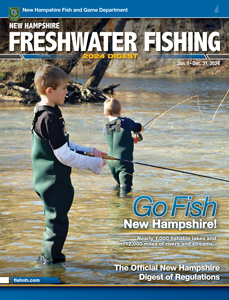Fish Consumption Guidelines
Is it Safe to Eat the Fish?
Mercury
Fish can be an important part of a healthy diet, but some fish contain varying levels of pollutants including mercury. Because of this, the NH Department of Environmental Services recommends the following guidelines for eating freshwater fish that you catch in New Hampshire:
- Pregnant and nursing women, and women who may become pregnant, can safely eat ONE 8-ounce meal of freshwater fish per month.
- Children under age 7 can safely eat ONE 4-ounce meal of freshwater fish per month.
- All other adults and children age 7 and older can safely eat FOUR 8-ounce meals of freshwater fish per month.
- When eating bass, pickerel, white perch, or yellow perch, limit consumption to fish 12 inches or less in length while following the above guidelines.
Stocked trout contains relatively low levels of mercury. For rainbow and brown trout, women of childbearing age and children under age 7 can safely eat ONE 4-ounce meal per week; others can eat SIX 8-ounce meals per week. Trout could be either stocked or from a wild population, and therefore, should be consumed at the rate of the general freshwater advisory above.
Fish from a number of waterbodies in New Hampshire have been shown to have higher than average concentrations of mercury or other contaminants. Learn more at des.nh.gov/home-and-recreation/boating-and-fishing/mercury-fish.
Other
Additional consumption guidelines have been issued because of the concern for PCB (polychlorinated biphenyls) contamination in several locations:
- Country Pond in Kingston
- Squam Lake in Holderness, Center Harbor, Sandwich, and Moultonborough.
- For the Souhegan River from the Goldman Dam to one mile upriver near Riverway East located off of Elm Street in Milford it is recommended in that section of river that anglers not eat, but catch and release any fish caught unharmed.
In addition, NO fish should be consumed from the Androscoggin River from Berlin south to the Maine border due to potential dioxin and mercury contaminations.
Additional consumption guidelines have also been issued because of the concern for PFOS (perfluorooctane sulfonic acid) concentrations in several lakes listed below. For women of childbearing age the guidelines remain the same as for mercury, but there are changes for adults and children as follows:
Waterbody |
Species |
Age Group |
Number of Meals |
Beaver Lake, Derry |
Large and Smallmouth bass |
Most adults & older children |
3 meals/month |
Children younger than 7 |
Same as mercury |
||
Robinson Pond, Hudson |
All freshwater fish |
Most adults & older children |
2 meals/month |
Children younger than 7 |
DO NOT EAT |
||
Horseshoe Pond, Merrimack |
All freshwater fish |
Most adults & older children |
1 meal/month |
Children younger than 7 |
DO NOT EAT |
||
Canobie Lake, Salem |
All freshwater fish |
Most adults & older children |
3 meals/month |
Children younger than 7 |
Same as mercury |
||
Cobbetts Pond, Windham |
Large and Smallmouth bass |
Most adults & older children |
2 meals/month |
Children younger than 7 |
Same as mercury |
For more information on freshwater and saltwater guidelines, contact: NH Department of Environmental Services, Environmental Health Program, 603-271-1370, des.nh.gov/home-and-recreation/boating-and-fishing/mercury-fish.

